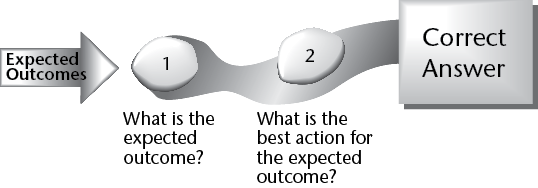

You spent much of your time in practical/vocational nursing school learning about what might go wrong with clients and their care. This makes sense; after all, nurses need to deal with problems and illnesses. Many test questions that your practical/vocational nursing school faculty wrote focused on what was wrong with clients and their care. In order to prove minimum competence, the beginning practical/vocational nurse must demonstrate the ability to make appropriate nursing judgments. Competent nursing judgments include recognizing both expected and unexpected behaviors, so it is important for you to recognize expected outcomes on the NCLEX-PN® exam. Expected outcomes are the behaviors and changes you think are going to occur as a result of nursing care. These outcomes allow the nurse to evaluate whether goals have been met.
Look at the following question.
If this question were included on one of your fundamentals tests, you would assume that a problem was being described. You would choose an answer that involved “fixing” the problem. Let’s look at this question.
THE REWORDED QUESTION: What should you do with a client with these electrolyte results?
Step 1. Recognize normal. Interpret the serum electrolyte results. All are within normal limits.
Step 2. Decide how you should use this information. Because the values are all normal, let’s reword the question again using this information.
Now THE REWORDED QUESTION is: What should you do for a client with normal serum electrolytes?
ANSWERS:
The correct answer is (3). The electrolytes are within normal limits. Some students select answer choice (1) because they think there’s something they missed, or it must be a trick question. The “trick” is deciding whether the information that you are given is normal or abnormal, and then answering the question accordingly.
Try this question.
THE REWORDED QUESTION: What should you do for this client?
To answer this question you need to know what these vital signs indicate.
Step 1. Recognize normal. Nitroglycerin is a potent vasodilator with anti-anginal, anti-ischemic, and antihypertensive actions. It increases blood flow through the coronary arteries. Side effects include orthostatic hypotension, tachycardia, dizziness, and palpitations. Decreased blood pressure, increased pulse rate, and stable respiratory rate after administration of a potent vasodilator is normal and expected.
Step 2. Decide how you should use this information. The question should be reworded as, “What should you do for a client who has responded as expected to a dose of nitroglycerin?”
ANSWERS:
The correct answer is (4). You would expect a client’s blood pressure to decrease after administration of nitroglycerin. The key to this question is understanding how the medication works and correctly identifying the expected outcome.